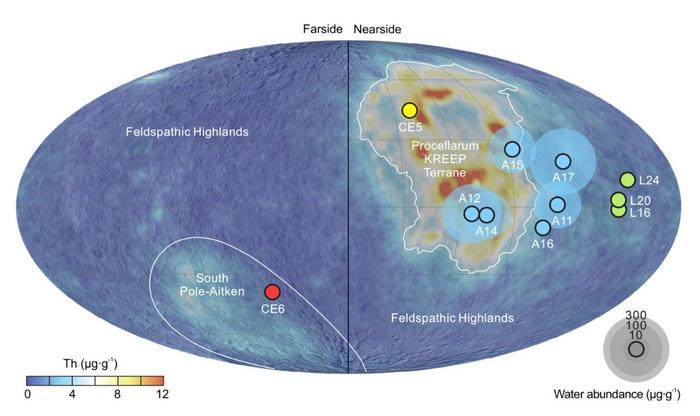Chinese scientists have made a groundbreaking discovery about the Moon’s mantle, revealing significant differences in water content between the lunar nearside and farside. This research was spearheaded by a team led by Professor Hu Sen from the Institute of Geology and Geophysics at the Chinese Academy of Sciences. Their findings shed light on the Moon’s geochemical makeup and have potential implications for understanding its formation and evolution.
The team’s study, published in the esteemed journal Nature, focused on analyses of basalts collected during the Chang’e-6 lunar mission. These basalts provided critical data, enhancing our understanding of the Moon’s internal structure and the distribution of water within the lunar mantle. The results indicated that the lunar farside contains water concentrations of only 1 to 1.5 micrograms per gram (μg/g), making it significantly drier compared to the nearside.
Over the last two decades, extensive examinations of lunar samples from the nearside have established a dynamic and heterogeneous water distribution within the Moon’s interior. Water concentrations there have been found to fluctuate dramatically, ranging from approximately 1 to 200 μg/g, thus indicating a variation in the Moon’s compositional landscape.
An intriguing aspect of this study is the note about the Procellarum KREEP Terrane, located on the lunar nearside. The crust in this region exhibits elevated thorium (Th) concentrations, distinguishing it from two other primary geochemical provinces, namely the Feldspathic Highlands and the South Pole–Aitken (SPA) Basin found on the farside. Such variations in elemental concentrations are essential when discussing the history of lunar volcanism and the Moon’s thermal evolution.
Both thorium and water are classified as incompatible elements during magmatic processes. This implies they preferentially stay in the molten phase of the rock, avoiding incorporation into forming minerals. These behavioral traits suggest that the mantle beneath the SPA Basin on the lunar farside is less enriched in water than that beneath the nearside regions, presenting a striking asymmetry in water distributions.
The research team meticulously evaluated water content and hydrogen isotopes within melt inclusions and apatite in the CE6 mare basalts—the first samples ever retrieved from the Moon’s far side. This comprehensive analysis allowed the researchers to verify their hypotheses, affirming that the parent magma of these basalts contained between 15 and 168 μg/g of water. They concluded that the mantle source of the CE6 basalts possesses an even lower water content than previously anticipated.
Such discrepancies in water content between the Moon’s hemispheres suggest the presence of a pronounced hemispheric dichotomy in internal water distribution. This disparity not only mirrors existing asymmetries seen on the lunar surface but also poses intriguing questions regarding the processes that shaped the Moon over billions of years.
The new estimates derived from this research mark significant progress in our comprehension of the bulk silicate Moon’s water inventory. These insights are particularly relevant to discussions surrounding the giant impact hypothesis, which theorizes how the Moon was formed. Understanding the role of water, or the lack thereof, within the mantle is critical to piecing together the Moon’s long-term geological history.
Collaboration played a vital role in this study, with contributions from Nanjing University being instrumental. The research was supported by various organizations, including the National Natural Science Foundation of China and the Strategic Priority Research Program of the Chinese Academy of Sciences, underscoring the importance of collaborative efforts in furthering lunar research.
Moreover, the findings of this study inspire further questions about how water is distributed in other celestial bodies and what it means for their geochemistry and potential habitability. As scientists continue to study the Moon and beyond, these revelations about the lunar mantle will undoubtedly serve as a launching pad for future exploration and discovery.
This significant advancement in understanding the Moon’s internal composition has implications not just for lunar science, but also for planetary sciences at large. As we enrich our knowledge of our closest celestial neighbor, we can glean more about the evolutionary processes that govern not only the Moon but potentially other worlds in our solar system as well.
The conditions that led to such varying levels of water content could very well reflect ancient volcanic activity, thermal evolution, and even the effects of cosmic impacts, thus providing a fuller picture of the Moon’s dynamic history. Ultimately, ongoing research will continue to unravel the complexities of lunar geology as scientists strive to piece together the intricate puzzle of the Moon’s origins.
As lunar missions expand, our grasp of the Moon’s mantle will be further refined, opening up new frontiers in planetary research. The Chang’e-6 mission and subsequent studies signify a new era in lunar exploration, one that holds promise not only for understanding the Moon but for addressing broader questions about planetary formation, evolution, and the distribution of vital resources across the solar system.
Subject of Research: Lunar mantle water content disparity
Article Title: Chinese Scientists Discover Water Content Disparity in Moon’s Mantle
News Publication Date: October 16, 2023
Web References: Nature Article
References: Nature Journal, Chang’e-6 Mission Reports
Image Credits: Image by Prof. Hu Sen’s group
Keywords
lunar research, water content, Chang’e-6, Moon, geochemistry, planetary science, lunar mantle, thorium concentration, hemispheric dichotomy, basalt analysis, cosmic evolution, lunar exploration




